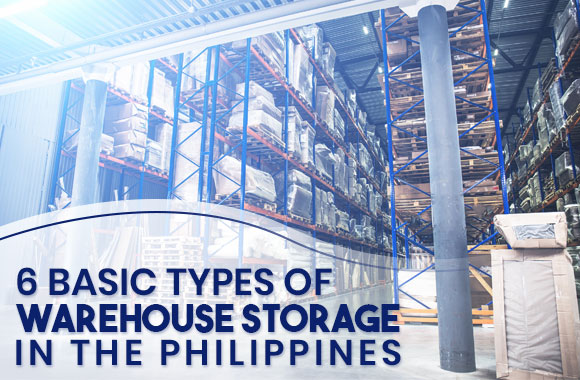Choosing the right type of warehouse storage will enable you to maximize available space and speed up warehousing operations at the same time. Did you know that there are 6 types of warehouse storage you can choose from? To help you decide, we’ve listed down these 6 basic types together with their defining features and best applications.
6 Essential Types of Warehouse Storage in the Philippines
1. Static Shelving
With static shelves, warehousing personnel can access goods easily, as if they were reaching for items on display at a shop. This type of warehouse storage can be further divided into two types:
• Short span shelving, which is ideal for smaller, light-duty goods
• Long span shelving, which uses spacious heavy-duty shelves
Static shelving is best for small, light items such as machine parts, clothing, ornaments, and produce. Most shelves in Philippine warehouses can only carry up to a few hundred kilograms of goods.
2. Mobile Shelving
This type of warehouse storage uses movable shelves fitted with a traction system. Mobile shelving is good for archiving, data storage, and other applications where access isn’t always needed. It also makes the most of available storage space, which is often at a premium for warehouses in the Philippines. With this type of warehouse storage, tracks for the shelves are either mounted or built into the floor.
3. Pallet Racking
Pallet racking is the ideal type of warehousing storage if you store items in boxes or crates and maintain inventory logs. Warehouse storage of this type is also best for large and busy warehouses, such as cargo agents in the Philippines.
Be sure to account for accessibility, weight, stability, and storage space if you use pallet racking. Warehousing personnel should strictly observe weight limits to avoid boxed goods from toppling or getting crushed.
Pallet racking systems can be further classified into 13 subtypes:
• Carton flow racking or carton live storage uses slanted bays with roller tracks. This makes it easy to replace stock. It is ideal for small items without boxes.
• Cantilever racking is suitable for long, oversized loads such as plasterboard, pipes, and lumber. It uses beams which anchor at one end.
•Coil racking consists of spooling coils from which chains and cables can be pulled and cut.
• Double deep racking requires specially designed forklifts or handling attachments to retrieve pallets which are stored two rows deep.
• Drive-in racking helps create more space by placing pallets so that they can slide back on a rail.
• Drive-through racking is similar to drive-in racking, except that pallets can be accessed from both sides instead of just one.
• High-bay racking uses racks fixed to the walls and roof for higher storage. Personnel may access goods with the help of an automated retrieval system.
• Similar to mobile shelving, mobile racking uses movable racks which can be placed closely together. It also uses an automated retrieval system together with sensor technology.
• Narrow aisle racking can also help you maximize storage space through more compact systems. There are now forklifts specifically designed for the tighter spaces in this type of racking.
• Pallet live racking or gravity flow racking harnesses gravity to move goods along inclined rollers.
• In push back racking, goods can be pushed further back into aisles which are designed to be deeper than usual.
• Shuttle racking uses a self-powered device that shuttles pallets through the system.
• Vertical racking stores long stock upright and secures it with metal arms. Goods are often stored individually for easy access.
4. Multi-Tier Racking
In multi-tier racking, tiers of shelves are stacked on top of one another to take advantage of warehouses’ vertical space. Warehousing personnel can manually access goods up to the maximum limit of vertical storage. Tiers can be added or removed as needed later on.
This type of warehouse storage often combines mezzanine flooring and stairs, though some warehouses in the Philippines also feature scissor lifts. Because multi-tier racking uses warehouse space so efficiently, it is suitable for storing large quantities in small spaces.
5. Mezzanine Flooring
Mezzanine floors are essentially additional levels installed on top of existing aisles in the warehouse. These are often customized to different warehouses thanks to technological advancements. Some warehouses in the Philippines have two or three extra levels because of mezzanine flooring.
Depending on your warehousing requirements, this type of warehouse storage can come with the following accessories:
• Suspended ceilings
• Built-in light fixtures
• Compatible lift systems
• Fire safety features
6. Wire Partitions
Unlike more permanent types of warehouse storage in the Philippines, wire partitions can be installed and removed quickly. These wire cages are often used for goods that need special security. They are also sometimes used to build makeshift offices for managers.
ALSO READ: 5 Ways Warehouse Management Can Help Your Company
Do you have an idea of which type of warehouse storage your company will need? To ensure a sound decision, consult an industry expert such as Worklink Services, Inc. (WSI) before purchasing or installing any new storage technology.
Since 1999, WSI has been offering reliable warehousing solutions and courier services to clients in the Philippines. All this prior experience has made WSI into a trustworthy resource on warehousing in the Philippines, as well as reliable B2B courier company in the country. Contact us today, and we can help optimize your warehouse operations together with your company logistics as a whole.
Found this article informative? Visit our blog for more posts about warehousing in the Philippines.


